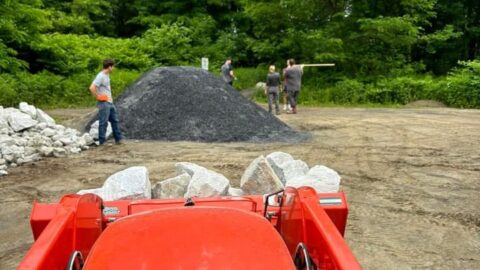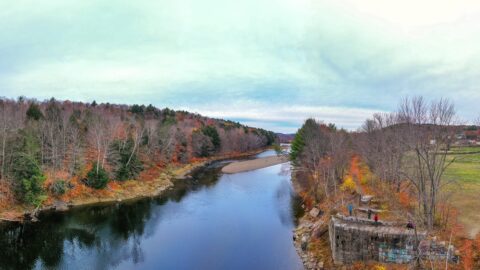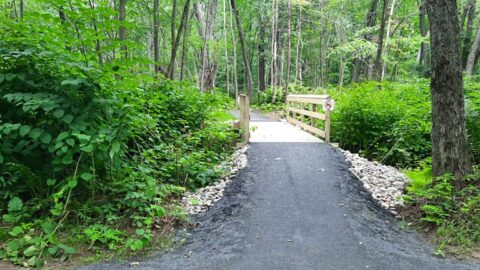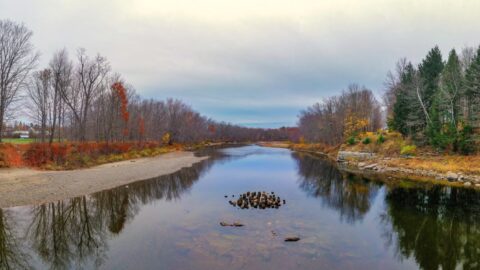
Sandy River Bridge
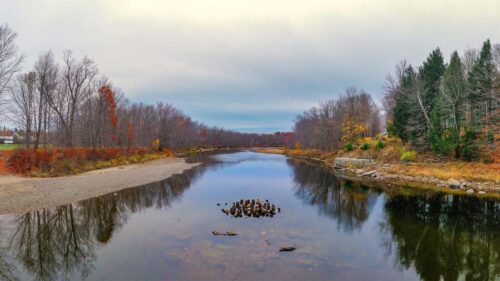
Rebuilding the Sandy River Bridge
Rebuilding the 336-foot multi-use Sandy River bridge to connect the regional Whistle Stop Trail to downtown Farmington has been one of this region’s biggest opportunities.
The 14-mile Whistle Stop Trail is a successful rail-to-trail project that runs from West Farmington to Jay, connecting hundreds of recreationalists with businesses along the way. Whistle Stop is open to walking, biking, skiing, horseback riding, snowmobiling, and ATVs.
The Sandy River bridge will be owned and managed by the Maine Bureau of Parks and Lands as part of the Whistle Stop Trail.
The Economic Impact of the Sandy River Bridge
In 2021, we obtained an economic impact statement from the University of Southern Maine, which highlighted an $861,000 annual impact on the local economy through increased visitor spending, as well as $103,000 in annual tax revenue.
This spending accounted for an additional 13 jobs created or retained. This is on top of the $1.5 million in regional construction spending that will create 25 temporary jobs.
Sandy River Bridge Timeline
1999
The former bridge, which stretched from the West Farmington side of the Sandy River to the Prescott Field Trail System, was deemed unsafe from hurricane damage and is torn down.
The State of Maine through its Bureau of Parks and Lands (BPL), acquires the Whistle Stop Trail.
2003 & 2005
BPL secured access easements on both sides of the Sandy River to rebuild this bridge and connect to the downtown
2007
The Town of Farmington and the State of Maine created a preliminary bridge design that estimated the total project cost at $1.7 million. At the time, there weren’t the resources or grant opportunities, so the committee decided to stop moving forward.
2010
The Sandy River Bridge project bubbled up again as a recommendation of the Maine Downtown Center’s Green Downtown Plan as the number one key strategic improvement.
2013
The Town of Farmington created a downtown development plan. This plan helped inform the creation of a Downtown TIF district. In these plans, the desire to rebuild this bridge was front and center. There were articles at the time with local business owners supporting this project. In the final downtown plan, it was recommended that fundraising should be renewed.
2015
The Town of Farmington’s Comprehensive plan included the Sandy River Bridge. Upon researching the project, it became evident that it was a priority for many demographics and organizations.
2021
The High Peaks Alliance hosted a stakeholder group of people who had worked on this project and organizations that could help. The consensus was that it would be great to rebuild the bridge, but how would we pay for it?
The question was daunting. Brent was only a year into his role as Executive Director and this would be an undertaking larger than any other in our organization’s history. The project was too large for the Town of Farmington alone. BPL was willing to be the long-term owner and maintainer but had limited capacity.
The Economic Development Administration’s (EDA) Travel, Tourism & Outdoor Recreation program’s one-time grant opportunity was a good fit for the project, although we would be competing with every city from here to Pittsburgh. We applied.
We had to have a new preliminary engineering plan, and an environmental narrative, meet the numerous federal requirements, and have 20% of the project funds secured as a match.
We also were able to get an economic impact statement from the University of Southern Maine, which highlighted an $861,000 annual impact on the local economy through increased visitor spending, as well as $103,000 in annual tax revenue.
This spending accounted for an additional 13 jobs created or retained. This is on top of the $1.5 million in regional construction spending that will create 25 temporary jobs.
2022
HPA worked on this project with the support of our members and the ME Timberland Trust. The total project budget is $2,751,451, with our request to the EDA at just over $2 million.
Our hope was buoyed when Susan and Fritz Onion said that they would get the project started with a $300,000 pledge. Their commitment to our communities and outdoor recreation is humbling.
“Fritz and I remember skiing and biking across the old trestle between Farmington and West Farmington in the 1980s. The rebuilding of the Sandy River trestle will be a great asset for the community through improving access and providing safe passage across the river while connecting the Whistle Stop Trail to downtown Farmington and the western foothills and mountains. We are thrilled that community support and funding have come together to help bring this project to fruition after all these years!” said Susan Onion.
With this first pledge, the Town of Farmington joined with a $200,000 contribution from their TIF funds. The Sandy River Charitable Foundation also pledged $100,000.
The State of Maine was also able to commit $50,000 from the snowmobile program.
The one gap in the project is how to support our organizational costs associated with facilitating this project and others. Tim Thompson, the president of Franklin Savings Bank, has seen this, and because of our work on this bridge, worked with Franklin Savings Bank’s Foundation to pledge $50,000 to our organization over the next five years.
Unfortunately, our grant request from 2021 to the EDA was declined. The grant was ultra-competitive, and given our low population, this project was no match for the massive economic impacts that projects could have in more heavily populated areas.
Although this was a major disappointment, we realized without the urgency of this opportunity, we would have never started to move the project so quickly. We had thought ahead and already spoken with our congressional delegation about potentially submitting this project for congressionally directed funding.
We were fortunate to be able to share our preliminary bridge designs with students in Foster Technology Centers CADD class. One student built a scale model. Students in Foster Tech’s Digital Media program filmed and produced created a video about it. Watch the whole story.
It caught the attention of Congressman Jared Golden, who enlisted in the Marines when he was a UMF student. This area was important to him. Congressman Golden’s staff walked us through the process and had us apply to Senator Susan Collins and Senator Angus King for congressionally directed funding as well. The project was selected to move through the appropriations process by all three!
We also applied for a Northern Border Commission Grant and to Franklin County’s American Rescue Plan’s funds.
Due to government shutdowns, the congressional vote to support this project was on 12/31/2022.
2023
Congress puts the project into an agency to administer. The Department of Housing and Urban Development (HUD) is chosen. HUD sits on the project for a year.
HPA was awarded $2,041,000 through the federal Fiscal Year 2023 Transportation, Housing and Urban Development appropriations bill. The request was supported and championed by Senator Collins, Senator King, and Representative Golden in the 2023 federal budget. Read the whole story.
The State of Maine begins working through a public bid process to find an engineering firm.
2024
Over the next year the permitting, grant clearances, and final engineering will take place.
April | The State of Maine received two qualified bids from engineering firms for the Sandy River Bridge.
June | The State selected the final engineering firm.
September | Awaiting a contract for final engineering.
2025
January | The State of Maine has hired the engineering firm Thornton Tomasetti from Portland to design, assess the impact, and evaluate the probable construction cost of the Sandy River Bridge project. Though this project is being pushed by the High Peaks Alliance, the bridge will be owned by the State of Maine and must go through a public bidding process. The design phase is expected to be completed by the end of 2025, after which the project will move into final permitting and construction.
Funding for the construction of this State-owned project has been secured through 2031. Meanwhile, the High Peaks Alliance, a non-profit organization, is actively fundraising to cover operational costs associated with seeing the project through to completion.
A quick note from Thorton Tomasetti:
While this project focuses on design of a new bridge to accommodate pedestrians and snowmobiles, we’re most excited about the unique opportunity to create a transformative link between West Farmington and the heart of the downtown. This project will support recreational access to the Sandy River and Farmington’s bold natural resources, while promoting economic development of the vibrant, historic downtown. We look forward to working with the community to ensure that this bridge becomes a meaningful and sustainable asset for the Town.
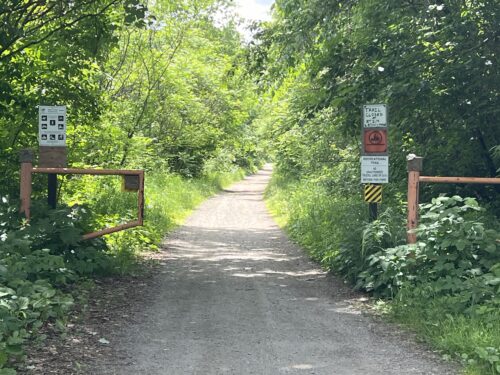
Explore the Whistle Stop Trail
Explore the beautiful Whistle Stop Trail connecting Jay, Wilton, and Farmington! This former railroad, now converted into a multi-use, four-season rail trail, offers endless opportunities for outdoor activities.
Whether you enjoy walking, biking, snowshoeing, or cross-country skiing, this trail has something for everyone. You can horseback ride, dog sled, ATV, or snowmobile.
The trail follows the gentle curves and slopes of the railroad bed, providing a wide and flat path that is perfect for leisurely walks or long-distance travel. You’ll be treated to views of Western Maine’s foothills, forested wetlands, and rural farmland.
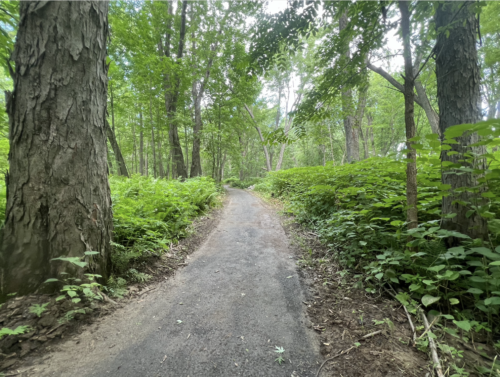
Explore the Prescott Accessible Trail
The Prescott Field Accessible Trail connects and is part of a larger, 5.1-mile, trail system throughout the fields and along the Sandy River and offers reroutes around steep areas. The trail surface is wide and stable.
This trail will connect to the Whistle Stop Trail upon the completion of the Sandy River Bridge. You can find information on the ADA trail at Maine Trail Finder and a full map on the UMF website.
Learn More About the Project
Receive updates about this and other projects by subscribing to our newsletter.

